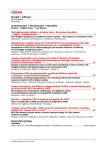News in classification of MDS and evaluation of prognosis by WPSS
Authors:
M. Žídková; J. Voglová; P. Bělohlávková; F. Vrbacký
Authors‘ workplace:
II. interní klinika- oddělení klinické hematologie, Fakultní nemocnice Hradec Králové a LF UK
Published in:
Transfuze Hematol. dnes,16, 2010, No. 1, p. 42-46.
Category:
Comprehensive Reports, Original Papers, Case Reports
Overview
Myelodysplastic syndromes represent a heterogenous group of clonal hematopoietic disorders. Accurate classification and prediction of survival are essential for selection of optimal therapy. The WHO classification-based prognostic scoring system permits more useful dynamic estimation of survival and risk of AML transformation in individual patients not only at the time of diagnosis but also throughout the course of their disease.
Key words:
myelodysplastic syndrome, classification
Sources
1. Malcovati L, Nimer S. Myelodysplastic syndromes: diagnosis and staging. C Cont 2008; 15: 4–13.
2. Mufti GJ, Bennet JM, Goasguen J, et al. Diagnosis and classification of myelodysplastic syndrome: International Working Group on Morphology of myelodysplastic syndrome (IWGM-MDS) consensus proposals for the definition and enumeration of myeloblasts and ring sideroblasts. Haematol 2008; 93: 1712–1717.
3. Malcovati L, Germing U, Kuendgen A, et al. Time-dependent prognostic scoring system for predicting survival and leukemic evolution in myelodysplastic syndromes. J Clin Oncol 2007; 25: 3503–3510.
4. Jädersten M, Hellström-Lindberg E. Myelodysplastic syndromes: biology and treatment. J Int Med 2008; 265: 307–322.
5. Muller-Berndorf H, Hass PS, Kunzmann R, et al. Comparison of five prognostic scoring systems, the FAB and WHO classifications in patients with myelodysplastic syndromes: results of a single-center analysis. Ann Hematol 2006; 85: 502–513.
6. Greenberg P, Cox C, LeBeau M, et al. International scoring system for evaluating prognosis in myelodysplastic syndromes. Blood 1997; 89: 2079–2088.
7. Hellström-Lindberg E, Cazzola M. The role of JAK2 mutations in RARS and other MDS. Hematology Am Soc Hematol Educ Program 2008: 52–59.
8. Mufti GJ, Chen TL. Changing the treatment paradigm in myelodysplastic syndromes. C Cont 2008; 15(Suppl. 4): 14–27.
9. Szpurka H,Tiu R, Murugesan G, et al. Refractory anemia with ringed sideroblasts associated with marked thrombocytosis (RARS-T), another myeloproliferative condition characterized by JAK2 V617F mutation. Blood 2006; 108: 2173–2181.
10. Schmitt-Graeff A, Teo SS, Olschewski M, et al. Jak2 V617F mutation status identifies subtypes of refractory anemia with ringed sideroblasts associated with marked thrombocytosis. Haematol 2008; 93: 34–40.
11. Malcovati L, Cazzola M. Myelodysplastic/myeloproliferative disorders. Haematol 2008; 9: 4–6.
12. Remacha AF, Nomdedeu JF, Puget G, et al. Occurrence of the JAK2 V617F mutation in the WHO provisional entity: myelodysplastic/myeloproliferative disease, unclassifiable–refractory anemia with ringed sideroblasts associated with marked thrombocytosis. Haematol 2006; 91: 719–720.
13. Steensma DP, Caudill JSC, Pardanani A, et al. MPL W515 and JAK2 V617 mutation analysis in patients with refractory anemia with ringed sideroblasts and an elevated platelet count. Haematol 2006; 91: 155–156.
14. Breccia M, Cannella L, Stefanizzi C, et al. WPSS versus simplified myelodysplastic syndrome risk score: Which is the best tool for prediction of survival in myelodysplastic patients? Leukemia Res 2008; 33: 93–94.
15. Alessandrino EP, Della Porta MG, Bacigalupo A, et al. WHO classification and WPSS predict post-transplant outcome in patients with myelodysplastic syndrome: a study from the Gruppo Italiano Trapianto di Midollo Osseo (GITMO). Blood 2008; 112: 895–902.
16. Malcovati L, Della Porta MG, Cazzola M. Predicting survival and leukemic evolution in patients with myelodysplastic syndrome. Haematol 2006; 91: 1588–1590.
17. Nimer SD. Myelodysplastic syndromes. Blood 2008; 111: 4841–4851.
18. Brunning RD, Orazi A, Germing U, et al. Myelodysplastic syndromes. In: Swerdlow SH, Campo E, Harris NL, et al.WHO classification of tumours of haematopoietic and lymphoid tissues. 4th edition. Lyon, IARC, 2008; 87–103.
19. Bennett JM. Myelodysplastic syndromes: update on classification. Leukemia Res 2009; 3: S6–S8.
20. Vardiman JW, Thiele J, Arber DA, et al. The 2008 revision of the World Health Organization (WHO) classification of myeloid neoplasms and acute leukemia: rationale and important changes. Blood 2009; 114: 937–951.
Labels
Haematology Internal medicine Clinical oncologyArticle was published in
Transfusion and Haematology Today

2010 Issue 1
Most read in this issue
- Unsuspected 18F-FDG PET/CT positive findings in the response evaluation or follow-up of non-Hodgkin’s lymphoma patients
- The changes in the nomenclature, classification and diagnostic criteria of myeloproliferative disorders according WHO classification 2008
- News in classification of MDS and evaluation of prognosis by WPSS
- Non-Hodgkinęs lymphomas in childhood in Slovak republic – the incidence and treatment results
